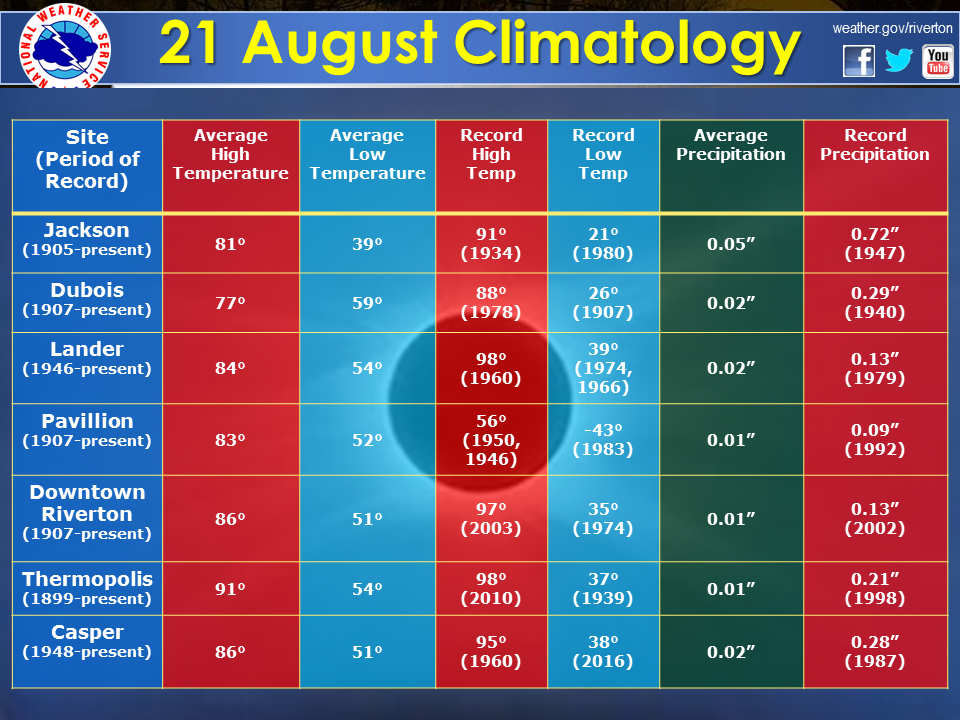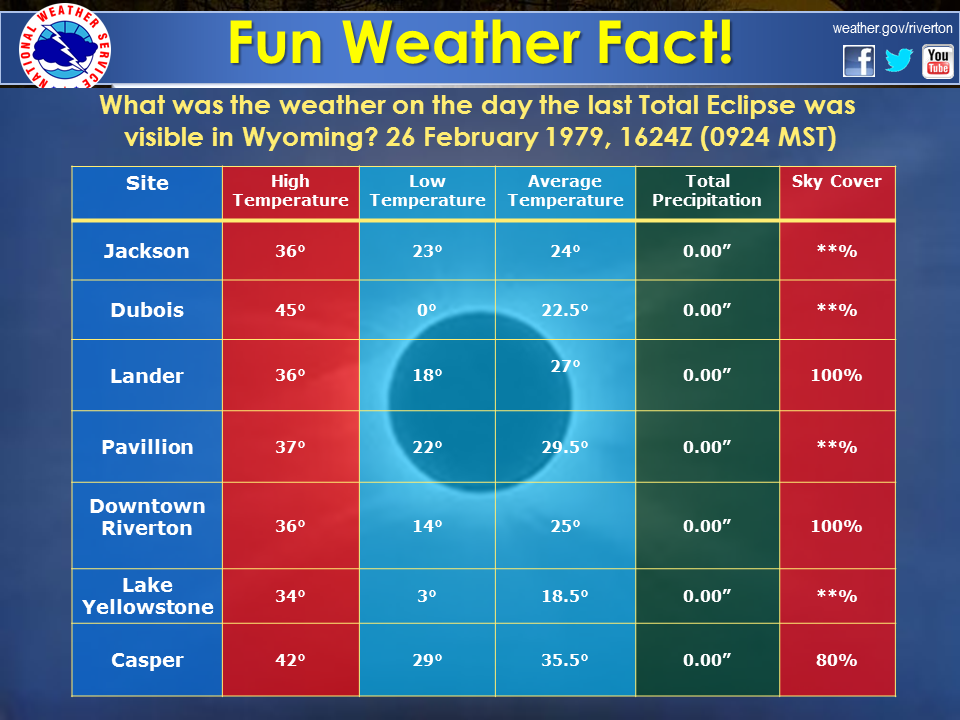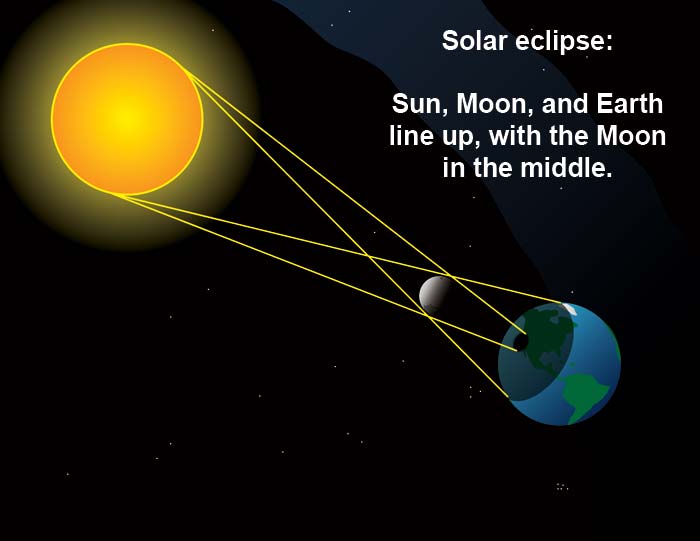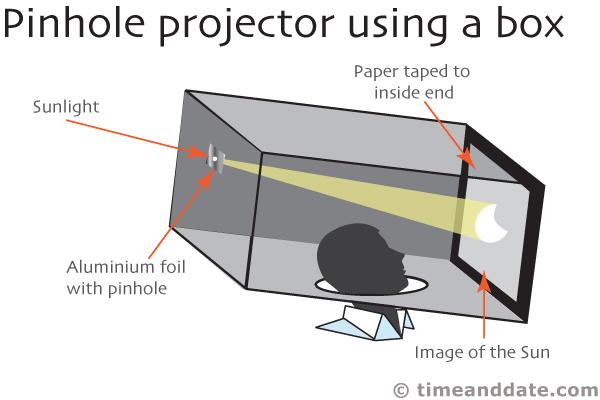
2017 Solar Eclipse
Summary and Eclipse Path | Climatology | Forecast | What is an Eclipse?
A total solar eclipse will track from the Pacific coast to the Atlantic. The shadow of the moon will begin over Oregon and move east to Idaho, Montana, Wyoming, Nebraska, Kansas, Missouri, Illinois, Kentucky, Tennessee, Georgia, and South Carolina. Totality will begin over the US in Newport, OR at 11:16 MDT and will end near Charleston, SC at 12:48 MDT. A partial solar eclipse will be viewable over the rest of the US. Totality will track directly across Wyoming and Nebraska. At the center of totality the moon will block out the sun completely for approximately 2 minutes 40 seconds. Totality time will decrease the further you are away from the center of totality. An event of this magnitude will not occur again until 2045.
Blue Line: Center of Totality Red Lines: Northern and Southern Boundaries of Totality |
| Wyoming Eclipse Map - Path and Times | ||
 |
 |
|
|
Click on Images to Enlarge |
||
Sunshine over most of Wyoming in the summer is a common occurrence, about 75% of the time during the summer. A minimum in cloudiness occurs in the late summer especially during the morning hours. Cumulus clouds develop almost every day contributing to partly to mostly cloudy afternoons. If you are looking for the odds of seeing the solar eclipse Wyoming the odds are in your favor. The solar eclipse will reach totality from 11:34 to 11:48 AM lasting for just over 2 minutes.
 |
 |
|
| Click on Images to Enlarge | ||








Photo credit: Wyoming Climate Atlas, University of Wyoming

Monthly cloud statistics based on daylight hours only. A clear day is defined as a day with zero to three-tenths average sky cover. Due to rounding annual totals may differ from 12-month totals.
Choose a forecast product type (temperature, wind, cloud cover, etc) and desired time from the menu/slider bars at the top of the map. The map will update automatically. Use your mouse to zoom into/pan around on the map
There are 2 different types of eclipses: solar and lunar.
A lunar eclipse happens at nighttime and occurs when the moon passes through the shadow of the Earth. These types of eclipses are much more common and generally last for a few hours.

A lunar eclipse is generally viewable in the locations in which it is nighttime. Lunar eclipses occur roughly 2 to 4 times per year.
Solar eclipses on the other hand are a rare special to see. Solar eclipses occur when the moon passes in between the Earth and the Sun.

Eclipse safety below will explain the dangerous of viewing a solar eclipse and how to view one safely.
Solar eclipses can be broken up into 2 categories: Partial and Total. Partial solar eclipse is when the moon does not completely block out the Sun. This is due to there the Moon, Sun, and Earth do not form into a perfectly straight line. A total solar eclipse is what we will experience on August 21, 2017. The Moon, Sun, and Earth will align and the moon will completely cover the sun. Only during this time is it safe to look at the eclipse without any eye protection. This will only last for a few minutes before the Moon moves and the sun will begin to reappear.

Safety is a big concern when viewing a solar eclipse. You should NEVER look directly at the sun during an eclipse. Looking directly at the sun is only safe during the few minutes when the sun is at the totality. That will only occur in the very narrow path of about 60 to 70 miles wide from Oregon to South Carolina (see map above).
The only way to safely observe a partially eclipsed sun is through special solar filtered glasses. Homemade filters and ordinary sunglasses, are not safe for looking at the Sun. There are several manufactures of eclipse glasses to meet international standards.

Glasses can be found at various online retailers and are generally inexpensive. Be sure to follow any packaging instructions and supervise children using solar glasses.
If you are looking for a DIY solar eclipse viewer a pinhole projector is a safe but indirect way to view a solar eclipse.

Other ways to view a solar eclipse include: